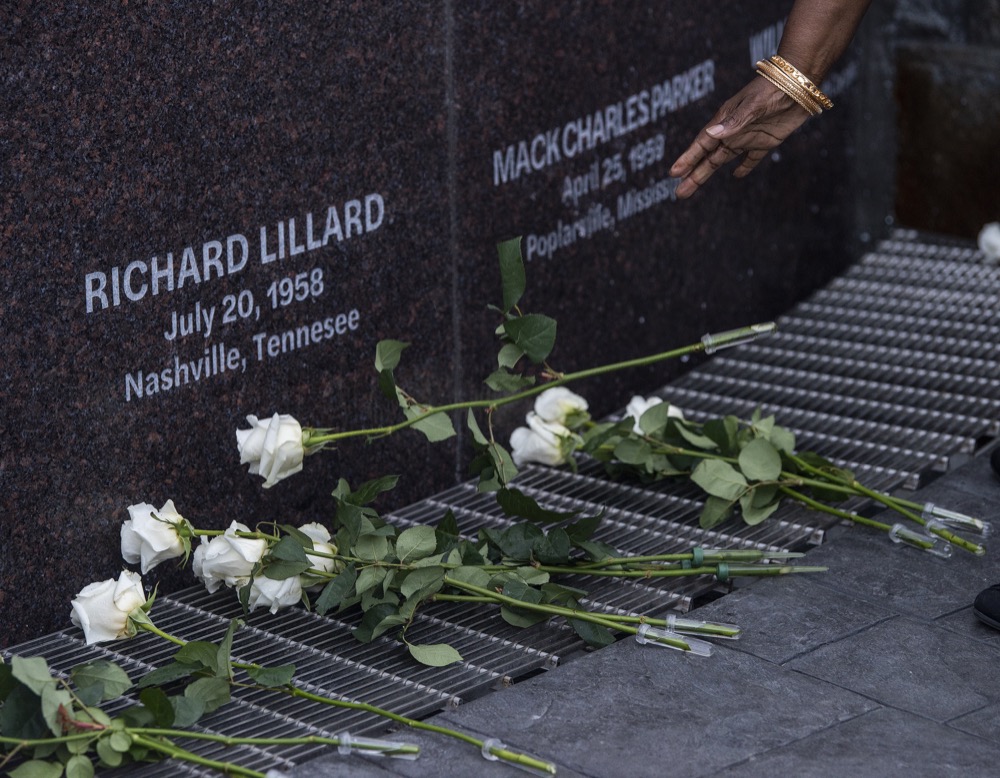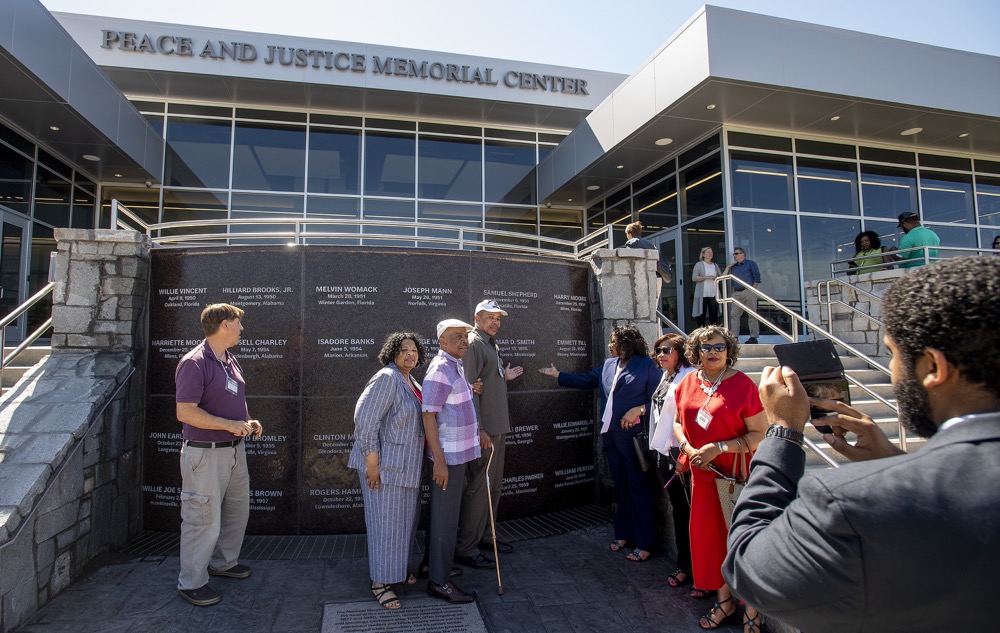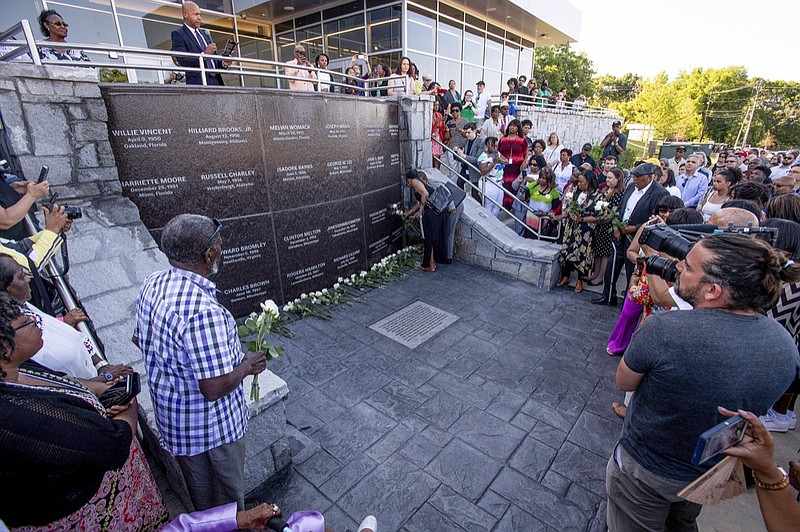 Roses are placed by family members of the deceased during the dedication of the new monument to those who were victims of racial terror lynchings or violence during the 1950s at the Peace and Justice Memorial Center in Montgomery, Ala., on Monday, April 29, 2019. (Mickey Welsh/The Montgomery Advertiser via AP)
Roses are placed by family members of the deceased during the dedication of the new monument to those who were victims of racial terror lynchings or violence during the 1950s at the Peace and Justice Memorial Center in Montgomery, Ala., on Monday, April 29, 2019. (Mickey Welsh/The Montgomery Advertiser via AP)
MONTGOMERY, Ala. (AP) - On a bitter January night in 1957, Willie Edwards Jr. stood, surrounded by four Klansmen, bloodied and begging for his life on the edge of a bridge.
The men were told a black Winn-Dixie truck driver had smiled at a white woman. They spent the evening stalking his route until they spotted Edwards sitting in his truck.
After "slapping him around a bit" and threatening to remove pieces of him, they drove Edwards to the middle of the bridge, 50 feet above the muck and murk of the Alabama River.
They had the wrong person, Edwards said. He was covering someone else's route. He told them about his two daughters and pregnant wife and pleaded for a chance to return home to them.
"Hit the water," said one of the men.
Edwards screamed and leapt into darkness. He was found dead in the Alabama River in April 1957.
Edwards is one of 24 victims of lynchings and racial violence honored at a new monument erected by Equal Justice Initiative, a nonprofit law firm and educational organization based in Montgomery.
The monument - remembering those killed in the 1950s - was unveiled Monday, a year after the organization unveiled the National Memorial for Peace and Justice honoring 4,000 victims of racial terror lynchings between 1877 and 1950.
Edwards' former wife, now remarried and named Sarah Salter, still remembers the last words he said before he left that long-ago night.
Edwards had only been a truck driver with Winn-Dixie for three months, but with two daughters and a third child on the way, he couldn't say no when asked to cover another driver's route. And he couldn't know that the driver he was replacing was wanted by the Ku Klux Klan.
After pulling on a pair of blue jeans - the ones Salter had stitched together with red yarn - Edwards stopped before the door, touched her stomach and told her, "Take care of my son."
"How do you know it's a boy?" she asked.
 The descendants of victim Lamar Smith take a photo before the dedication of the new monument to those who were victims of racial terror lynchings or violence during the 1950s at the Peace and Justice Memorial Center in Montgomery, Ala., on Monday, April 29, 2019. (Mickey Welsh/The Montgomery Advertiser via AP)
The descendants of victim Lamar Smith take a photo before the dedication of the new monument to those who were victims of racial terror lynchings or violence during the 1950s at the Peace and Justice Memorial Center in Montgomery, Ala., on Monday, April 29, 2019. (Mickey Welsh/The Montgomery Advertiser via AP)
"I know I have a son," Edwards replied.
Salter woke up repeatedly that night, wondering where Edwards had gone. The next morning, her mother tried to comfort her: "Maybe he picked up an extra shift?"
Then came the knock on the door. It was the police. Edwards' truck had been found, the driver's door open and the lights still on.
"He left for work and didn't come back that night," Salter said. "They made him go to the bridge and they made him jump off."
But Salter wouldn't know Edwards was dead for three months, a period of uncertainty she called "the worst time of my life." She wouldn't find out the details of that night or who was responsible for another 19 years.
"I was seven months pregnant and I had to go through and have the pregnancy by myself without my husband. It was devastating," Salter said.
In April 1957, Salter gave birth to a baby boy. Edwards had been right. A week later, his body was found 10 miles downriver by fishermen in Lowndes County.
He was badly decomposed but she recognized his eyes. His jeans were in tatters but she recognized her stitching.
"He was the most wonderful truck driver in the world. Nice guy. Beautiful smile," Salter said. "When my son comes to see me he says, 'Mama you have been my mother and my father all of my life. I regret so much I never got to meet my dad.' But I tell him he had the most wonderful dad and he took care of us. We didn't have very much but he took care of us and did everything he could possible to make me and my two girls at the time happy. I will always miss him."
The most recognizable name on the new monument wall is that of Emmett Till, who was lynched as a 14-year-old for allegedly flirting with a 21-year-old white woman in Mississippi in 1955. Till was abducted, beaten, shot and then dropped from a bridge into the Tallahatchie River, a 75-pound cotton gin fan fastened to his neck with barbed wire.
Like Edwards, two fishermen found Till's mutilated body. His open casket funeral opened the eyes of the nation to the realities of lynchings and the perverseness of vigilantes who stole lives of black citizens under the false guise of justice.
"It makes me feel good that he is going to be standing for something. That his life meant something," Edwards' daughter Mildred Betts said while visiting Montgomery Monday.
The lynching of Willie Edwards is unlike most lynchings that occurred in the earlier part of the 20th century in that Edwards' disappearance was investigated by police.
In 1976, Klansmen Sonny Livingston, Henry Alexander, and Jim York were indicted on first-degree murder charges after another Klansmen, Raymond Britt, agreed to submit an affidavit in exchange for immunity.
Edwards' daughter, Malinda Edwards, traveled back to Montgomery for the 1976 trial, she said in an interview with the Advertiser.
She watched as Judge Frank Embry waived the indictments, saying that the death certificate offered no cause of death and that, "Merely forcing a person to jump from a bridge does not naturally and probably lead to the death of such a person." It didn't help that Britt's testimony waivered on the stand and Livingston passed lie-detector tests while maintaining he wasn't involved.
"That hurt me to my heart. That was an injustice right there," Malinda Edwards said.
Two decades later, the family would have another chance. A deathbed confession by Alexander to his common-law wife sparked a fire in Malinda to again seek justice for her father's death. A grand jury failed to return an indictment, ending the possibility of prosecution.
Salter and her daughters said they appreciate the monument, the permanence of it. None said it brought them closure.
"At least we get more of the story sometimes, and people contact us just wanting to memorialize him, which is nice," Malinda Edwards said.
"Yeah," Betts said. "But I'd rather have him."
